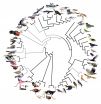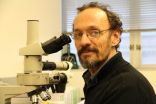(Press-News.org) The most ambitious genetic study ever undertaken on bird evolution has found that almost all modern birds diversified after the dinosaurs became extinct 66 million years ago.
"The popular view until now has been that the extraordinary diversity of birds began during the dinosaur age but we found little support for this," said Associate Professor Simon Ho, from the University of Sydney who led a major component of the research looking at evolutionary timescale.
An international collaboration of scientists worked for four years to sequence, assemble and compare the full genomes of 48 bird species representing all major branches of modern birds. It is the largest whole genomic study across a single vertebrate class ever undertaken.
Their results appear in a special edition of Science on 12 December (with simultaneous publications of related articles in other high profile journals).
Associate Professor Ho, from the University's School of Biological Sciences, is an author on a Science paper and two articles in GigaScience. He contributed his expertise in using a technique known as 'molecular clock' analysis to estimate birds' evolutionary timescales, using genome data and fossil evidence.
His research helped confirm that some of the first lineages of modern birds appeared about 100 million years ago but that almost all of the modern groups of birds diversified in a small window of less than 10 million years, just after the dinosaurs were wiped out by an asteroid.
"Our team had to develop a range of new methods to handle the largest bird data set ever assembled. These required the equivalent of more than 400 years of computing power across nine supercomputers," said Associate Professor Ho.
"The team was able to work out the relationships among the major groups of modern birds, showing that our previous understanding of birds had been clouded by the appearance of similar traits and habits in distantly related groups.
"So while grebes and cormorants are both waterbirds with webbed feet that dive to catch their prey they are, despite these similarities, from completely distinct lineages."
Another significant finding is that the ancestor of most of the land birds we see today is probably an apex predator that gave rise to raptors, eagles, owls and falcons in rapid succession before leading to land birds such as songbirds and woodpeckers.
"With the demise of the dinosaurs, birds and mammals were able to become more diverse and to occupy all of the niches that had previously been dominated by dinosaurs," said Associate Professor Simon Ho.
"This was one of the most significant episodes in the history of life on earth and it is tremendously exciting that this major scientific international effort has made these advances in our understanding," said Associate Professor Simon Ho.
INFORMATION:
Professor Eddie Holmes from the University of Sydney's School of Biological Sciences and Associate Professor Jaime Gongora and his research team from the Faculty of Veterinary Science also contributed to the international project and are authors on papers in Science and accompanying journals.
People with a high level of education who complain about memory lapses have a higher risk for stroke, according to new research in the American Heart Association journal Stroke.
"Studies have shown how stroke causes memory complaints," said Arfan Ikram, M.D., associate professor of neuroepidemiology at Erasmus University Rotterdam in The Netherlands. "Given the shared underlying vascular pathology, we posed the reverse question: 'Do memory complaints indicate an increased risk of strokes?'"
As part of the Rotterdam Study (1990-93 and 2000-01), 9,152 participants 55 ...
Children with public insurance waited longer after initial evaluation for sleep-disordered breathing (SDB) to undergo polysomnography (PSG, the gold standard diagnostic test) and also waited longer after PSG to have surgery to treat the condition with adenotonsillectomy (AT) compared with children who were privately insured, according to a report published online by JAMA Otolaryngology-Head & Neck Surgery.
Low socioeconomic status (SES) is a barrier to quality care and improved health outcomes. SDB is a spectrum of sleep disruption that ranges from snoring to obstructive ...
EAST LANSING, Mich. - It's well known that chemotherapy helps fight cancer. It's also known that it wreaks havoc on normal, healthy cells.
Michigan State University scientists are closer to discovering a possible way to boost healthy cell production in cancer patients as they receive chemotherapy. By adding thymine - a natural building block found in DNA - into normal cells, they found it stimulated gene production and caused them to multiply.
The study can be found online in the journal Molecular Cell.
"In most cases, cancer patients who receive chemotherapy lose ...
MADISON, Wis. -- Frederick Crane was a researcher under David E. Green in the mid-1950s, during the early days of the University of Wisconsin-Madison Enzyme Institute, when he made his defining discovery.
The lab group was on a mission to determine, bit by bit, how mitochondria -- the power plants of cells -- generate the energy required to sustain life. What Crane found, a compound called coenzyme Q, was a missing piece of the puzzle and became a major part of the legacy of mitochondrial research at UW-Madison. But it was no accident.
"It was the result of a long ...
Montréal, December 11, 2014 - Researchers in Montréal led by Jacques Drouin, D.Sc., uncovered a mechanism regulating dopamine levels in the brain by working on a mouse model of late onset Parkinson's disease. The study, conducted in collaboration with Dr. Rory A. Fisher from the Department of Pharmacology at the University of Iowa Carver College of Medicine, is published online today by the scientific journal PLoS Genetics.
Using gene expression profiling, a method to measure the activity of thousands of genes, researchers investigated dopaminergic neurons in ...
WEST LAFAYETTE, Ind. - A new method that creates large-area patterns of three-dimensional nanoshapes from metal sheets represents a potential manufacturing system to inexpensively mass produce innovations such as "plasmonic metamaterials" for advanced technologies.
The metamaterials have engineered surfaces that contain features, patterns or elements on the scale of nanometers that enable unprecedented control of light and could bring innovations such as high-speed electronics, advanced sensors and solar cells.
The new method, called laser shock imprinting, creates shapes ...
A new study led by researchers at University of California, San Diego School of Medicine finds that the brains of obese children literally light up differently when tasting sugar.
Published online in International Journal of Obesity, the study does not show a causal relationship between sugar hypersensitivity and overeating but it does support the idea that the growing number of America's obese youth may have a heightened psychological reward response to food.
This elevated sense of "food reward" - which involves being motivated by food and deriving a good feeling ...
PORTLAND, Ore. -- A large international group of scientists, including an Oregon Health & Science University neuroscientist, is publishing this week the results of a first-ever look at the genome of dozens of common birds. The scientists' research tells the story of how modern birds evolved after the mass extinction that wiped out dinosaurs and almost everything else on Earth 66 million years ago, and gives new details on how birds came to have feathers, flight and song.
The consortium of more than 200 scientists is publishing its findings nearly simultaneously this week ...
A team of researchers led by North Carolina State University has found that stacking materials that are only one atom thick can create semiconductor junctions that transfer charge efficiently, regardless of whether the crystalline structure of the materials is mismatched - lowering the manufacturing cost for a wide variety of semiconductor devices such as solar cells, lasers and LEDs.
"This work demonstrates that by stacking multiple two-dimensional (2-D) materials in random ways we can create semiconductor junctions that are as functional as those with perfect alignment" ...
Agricultural decisions made by our ancestors more than 10,000 years ago could hold the key to food security in the future, according to new research by the University of Sheffield.
Scientists, looking at why the first arable farmers chose to domesticate some cereal crops and not others, studied those that originated in the Fertile Crescent, an arc of land in western Asia from the Mediterranean Sea to the Persian Gulf.
They grew wild versions of what are now staple foods like wheat and barley along with other grasses from the region to identify the traits that make some ...

